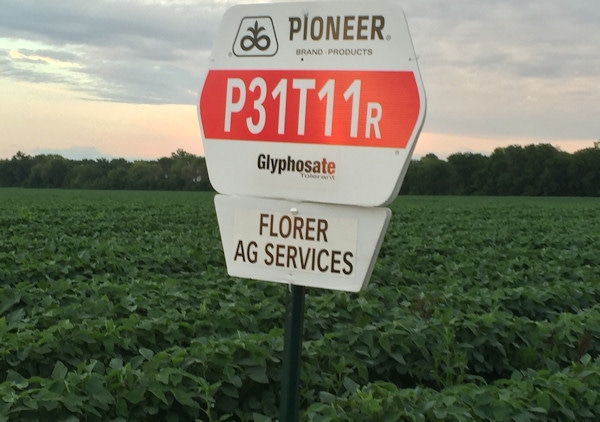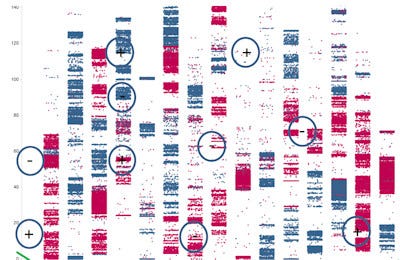July 20, 2016

Les Kuhlman is excited. His work as a senior research scientist for DuPont Pioneer, as part of the company's research effort, is starting to pay off big time. And the latest milestone of a nearly decade-long effort of the team Kuhlman works on is AYT 4.0.
AYT for Accelerated Yield Technology, is an idea that first started in 2007. That's when DuPont Pioneer announced it had refined a way to identify key yield components in the soybean genome and was using that information to guide development. Over that time, the process has been refined, with interim steps up to the announcement of AYT 4.0.
At its core, this latest tech development is the use of Big Data to significantly refine the decision making process for choosing the potentially higher-yielding soybean varieties for future development. Kuhlman, who works out of the DuPont Pioneer Lawrence, Kan., research facility on soybean development, says this latest advancement offers a significant potential for advancing higher-yielding varieties to market faster, and more efficiently that older methods.
"In traditional testing we would look strictly at yield for specific plants, and choose the higher-yielding phenotypes," he explains. "From that we would narrow our choices to get to specific varieties to move to further development."
That work was strictly based on yield seen in replicated plot trials, and he notes that sometimes that yield information might be flawed due to field tests where a deer might have dined on a plant in a short row, or the planter may have skipped at that point. These small plot trials would have what Kuhlman called "error variance" versus true "genetic variance."

Les Kuhlman, senior research scientist, DuPont Pioneer, Lawrence, Kan., explains the AYT 4.0 process and how it works to provide a more accurate picture of the true genetic yield potential of soybean varieties under development.
His work is at the start of the process for selecting the next-generation soybean varieties you might raise in the future. This is at a time when Pioneer might have 40,000 seed candidates that must be narrowed to 4,000 as part of a step-based system that finally leads to one winning soybean variety. It's tough out there for a rookie variety trying to get into the mini-bulk to be planted on your farm.
With AYT 4.0, the aim is to find the higher yielding plants by understanding their true genetic potential based on key yield factors and take "error variance" out of the picture.
In its release announcing AYT 4.0, Paul Stephens, senior director for soybean research, DuPont Pioneer, comments: "This is revolutionary technology that is helping deliver higher yielding soybeans to market faster than ever before. In my three decades of soybean variety improvement work, I have never seen rates of genetic gain as high as AYT 4.0 is producing."
The company claims it is doubling the annual rate of genetic gain of soybean varieties in its research pipeline. Currently that rate of gain is about a half-bushel per year, so the company is claiming a one-bushel boost in its yield development. And farmers are already planting one AYT 4.0 variety.
P31T11R is the first commercial variety developed using the technology, and it was released in 2015. In more than 300 trials the variety showed a yield advantage of 3.8 bushels per acre with a 77% win rate. The data is based on comparisons made in 2014 and 2015 in southern Iowa.
In addition, Pioneer claims it has shortened the development time for bringing new varieties to market. What was once as much as 12 years is now down to 5 to 7 years.
The newest AYT process
Back to Kuhlman, his colleagues and thousands of field tests going on every year. He offered insight into the mechanics of AYT and how it works to boost this genetic gain for the company. And the key is looking solely at genetic variance versus other factors. This is version 4.0 of that process and since 2007, Pioneer has come a long way in using genetic analytics to make decisions about which varieties to advance in the pipeline.
Kuhlman's field work is at the very early stages of the variety development process, where field researchers receive seed to plant in very limited quantities and must make some significant cut-and-run decisions on advancing varieties down the pipeline.
As Kuhlman explained, in the early days of development work at this stage aimed to choose the variety that had the highest harvested yield. That was the only metric they really had to go on. However with the soybean genome now mapped, and with the growing genetic information library at Pioneer DuPont for all of its parent varieties, more was possible.
In a hot Kansas field, Kuhlman points to row-upon-row of soybeans where in four long rows there are "families" of soybeans essentially plants from two parents and all the sisters in that family. Each of them must be evaluated to find the highest yielding progeny. However, simply looking at raw yield doesn't take out the "error variance" problem Kuhlman referenced, to select the right varieties to advance, researchers needed more information. Enter genetic analytics.
"During the season we take tissue samples of each of the plants in these plots and map their genetic traits," he explains. "We then compare those traits to specific yield markers to determine which have the highest predicted yield performance."

Once the plot is harvested, yield information is gathered for each plant, and using sophisticated genetic analytics, DuPont Pioneer scientists can
For example, one short row of plants may show a 65 bushel yield potential in the field trial while a neighboring test row shows 55 bushel potential. In the past, the 65-bushel yielder was the obvious choice, but layer in critical genetic data where Pioneer knows what traits mean yield and what traits don't - for that specific year's performance - and you may get a different answer.
"It could turn out the yield information from the field isn't right due to error variance," he says. "Genetic information and analyzing that along with yield data tells us which plants to advance in a much more precise way."
The testing isn't just done in Lawrence, Kan., there are field-plot tests being conducted in eight locations across the Midwest, each using the same data gathering technique. In essence, Pioneer ends up with a mountain of data on those early trial variety candidates to pore over and make much more precise decisions.
"We can get 150,000 data points from one population of plants, and we match them up with 1000 yield data points to model the genetic value of a variety," he notes. The field trials are set up so that there are 1,000 yield data points from each location for each family.
Adds Kuhlman: "This is data from one season for those varieties and we make those decisions based on that information. After that we start over."
Looking at the data
The tissue tests taken in season provide the genetic map of each variety plot in the trial. Post-harvest, the yield information for the same plots are rolled into the data set. And using sophisticated analytics Pioneer's data scientists can identify which traits in each plant are good or bad for yield.
This is where the magic of AYT 4.0 enters the picture. "We can look at those genetic pluses and minuses to determine the more likely candidates to advance based on their true genetic potential," Kuhlman says. "We're using predictive modeling to choose those varieties."
He says the process provides the true genetic value of that variety, and that's how the company then decides to advance the variety further into the pipeline. When plant breeders are looking at thousands of soybean variety candidates from which they must work to select the "winners" this Big Data approach is offering a different level of precision.
As for the future? "From 2007 to now has been an excellent ride and we're 100% invested in this, it's amazing what we might be able to do in five years," Kuhlman says.
About the Author(s)
You May Also Like






